And Now We Are 60: SLJ, the profession, and culture from 1954 to today

This month marks School Library Journal’s 60th year as an independent magazine—no small feat in this changing media landscape. With ongoing coverage of library news, big-picture issues, practical applications, and reviews, SLJ has worked to become an essential go-to guide for schools and librarians working with young people. As we observe this milestone, we look back at some highlights from the past six decades. In the September 1954 issue of Junior Libraries, a spin-off of Library Journal which became SLJ, educator Nancy Larrick explored a new concept called “individualized reading,” that requires an accessible place where children can browse a wide variety of books and make their own selections. How well they choose depends in part on the way the books are introduced and displayed. “With such a program, learning to read becomes a great adventure whereby children explore the world of books and sample the joys of reading.” Much has changed in the ensuing years, notably in the ways that information is gathered and shared, but our commitment to readers is as strong as ever.
 The 1950s
The 1950s
In its premier issue, editor Gertrude Wolf stated, “Junior Libraries comes to you at a time of high tide in the interest in children’s reading. Publishers are providing a wealth of attractive new books; curriculum makers are urging the use of a great variety of books to supplement the basic texts. Administrators and classroom teachers are increasingly aware of the school libraries’ vital contribution to effective teaching. School and children’s librarians are working creatively together, recognizing that the ‘child is their common denominator.’”
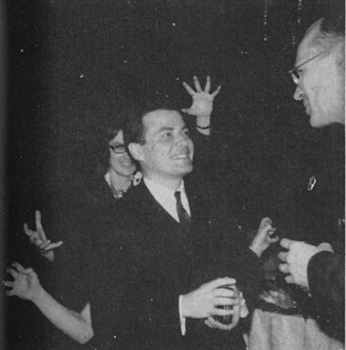 The 1960s
The 1960s
A growing concern for social justice was a hallmark of the decade, marked by the civil rights movement, Lyndon Johnson’s war on poverty, and the establishment of programs such as Head Start. Librarians did not shy away from the issues. SLJ gave voice to those who demanded diversity, such as librarian A. Grace Mims, who penned “Nervous Nellies on Race Relations?” in 1967. “Is it that librarians are more concerned with having ‘safe,’ sterile book collections than with having books that reflect realistically the true makeup of this diverse and ever changing democratic nation?” she wrote. Through it all, SLJ never lost its sense of fun and whimsy—especially when it came to beloved authors. When Maurice Sendak received the 1964 Caldecott Medal for Where the Wild Things Are, SLJ staffers were on hand to “make a wild thing out of Mr. Sendak” as he spoke to New York Times book review editor George Woods (pictured).
 The 1970s
The 1970s
Librarians grappled with the reality of school desegregation in the 1970s and a new understanding of librarianship—all in the midst of rising book prices and massive budget cuts. In SLJ, a 1971 editorial took the American Library Association (ALA) to task for not doing more to address lingering Jim Crow practices in southern school libraries. Feature stories throughout the decade such as “In House and Out House” (October 1971) and “A Feminist Look at Children’s Books” (January 1971) took a hard look at embedded racism and sexism within the literature and the profession at large. The ’70s also saw a growing understanding of the importance of early childhood education; public librarians were being asked to provide programs to toddlers and preschoolers—and they rose to the challenge. In March 1979, SLJ covered the emergence of a radical new type of library programming: toddler storytime, highlighting a pilot program in South Euclid, Ohio, for two-year-olds and their parents. Toward the decade’s end, school “librarians” had assumed an alternative title: “library media specialists.”
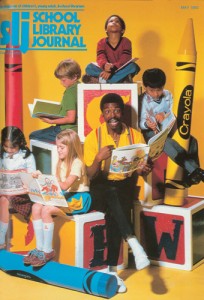 The 1980s
The 1980s
The Reagan years meant economic upheaval for America’s libraries, as tax revolts, slashed budgets, and staffing shortages became the norm. “It’s been said that libraries have no natural enemies, but neither do they have natural political allies,” wrote Ethel Manheimer in a SLJ feature, “Librarians as Political Activists,” in 1981. “It is up to us librarians to recruit our allies….The day of the low profile is over.” A Nation at Risk, a startling 1983 report by the NEA, warned of “the rising tide of mediocrity” in public education. A call for “back to basics” emphasized preschool services and led to the creation of Reading Rainbow and a national library card campaign. In SLJ, Roger Sutton wrote a piece about the allure of secret, forbidden passion in V. C. Andrews’s YA novels. And editor in chief Lillian Gerhardt attempted to put a stop to the perennial question: “Why not let THE CHILDREN choose the children’s book awards?” SLJ joined with ALA’s Young Adult Services Division (now YALSA) to sponsor the annual Margaret A. Edwards Award, honoring an author “for significant and lasting contribution to young adult literature.” The first Edwards Award went to S. E. Hinton in 1988.
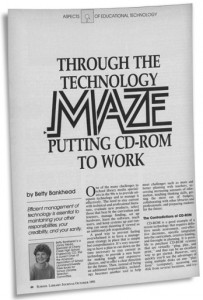 The 1990s
The 1990s
An October 1991 feature by Betty Blankhead considered technology—in the form of a CD-ROM collection development primer. The birth of the World Wide Web in 1992 was the ultimate game-changer. Media specialist Becky Mather shared tips on how to set up networking resources in the school media center, scrapping the idea of stand-alone computers and encouraging librarians to fight for a Local Area Network in their schools (“The Promised LAN,” October 1995). On the home front, SLJ gained a website, www.slj.com, on November 29, 1997, and in 1998, SLJ debuted its annual illustrated Best Books cover (by Christopher Myers). The magazine tracked important events of the world and the profession. In February 1991, SLJ was there to report ALA’s denouncement of President George Bush’s decision to enter the Gulf War—the first national organization to do so. The ’90s brought us No Child Left Behind, but also Harry Potter. Conceived in 1990 by author J. K. Rowling and already a worldwide phenomenon by 1999, the “Harry Potter” series (Scholastic) enchanted a generation.
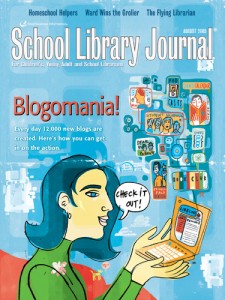 2000-2009
2000-2009
At the dawn of the new millennium, savvy professionals were abuzz with new formats, software, and platforms, which continued to revolutionize how and where our patrons read and accessed information. As the decade progressed, SLJ’s presence also expanded. In 2005, we hosted what became our annual leadership summit and, in 2009, Day of Dialog. Online, we debuted the Battle of the Kids’ Books in 2009. Virtual events followed, including The Digital Shift and later SummerTeen. SLJ also branched out into e-newsletters and webcasts. First out of the gate was Extra Helping, followed by Curriculum Connections, SLJTeen, and Series Made Simple. We also began reporting on a new trend—“Blogomania.” Just as technological advances influenced our reporting, so did world events. In the aftermath of 9/11, SLJ considered what it meant to be a nation at war and what the profession could offer in the way of services and information, reopening larger conversations about civil liberties, outreach, and underserved populations. Looking back, it’s not surprising that as Rowling’s epic fantasy was ending, dystopian literature was on its way to becoming the latest rage. Still, there was concern about “Generation Tech’s” declining interest in reading (“They Want Their MP3s”) and wondered “Do Books Still Matter?” as SLJ examined national surveys and statistics to get to “The Truth About Reading.” In 2008, we gained a new moniker, @sljournal, on Twitter. With subsequent outposts on Tumblr, Facebook, Flickr, Vimeo, and Pinterest, SLJ has embraced social media to better connect with our audience—wherever they are.

Timely issues: Concerns of the day, social and professional, got the cover treatment.
Clockwise from top left: Technological change; self-censorship; grassroots advocacy;
digital textbooks; bullying; and educational equity.
2010-2014
With new digs in downtown New York, SLJ underwent further change in the last few years without missing a step in covering and leading its ever-evolving beat. A new platform, WordPress, enabled a more effective Web presence. In collection development, we covered paranormal romance, steampunk, LGBT titles, and more, and in 2011 began reviewing apps. July 2013 saw SLJ’s first dedicated issue, on early learning, followed by one on diversity (May 2014). From flipped classrooms and Raspberry Pi to Minecraft and makerspaces, our feature well reflected an exciting trend toward students taking an active role in their own learning. 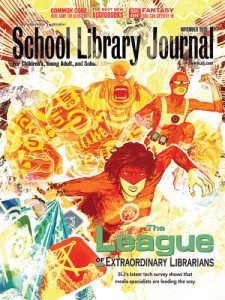 Ereaders—we reviewed a slew of them—came and went. But the iPad was clearly the dominant hardware, with the ubiquitous tablet considered in almost every issue. The advent of digital content elicited some skepticism, with more than a few headlines posing questions: “Are Ebooks any Good?” (2011) and “Is the iPad Fit for School?” (May 2010).
Ereaders—we reviewed a slew of them—came and went. But the iPad was clearly the dominant hardware, with the ubiquitous tablet considered in almost every issue. The advent of digital content elicited some skepticism, with more than a few headlines posing questions: “Are Ebooks any Good?” (2011) and “Is the iPad Fit for School?” (May 2010).
Despite the rocky, ongoing evolution—the ebook wars rage on to this day—librarians have been at the center, embracing familiar analog tools and emerging digital ones to enhance literacy. Case in point: librarian John Schumacher pictured with a stack of books under one arm, an iPad in another, which was among our most popular covers.
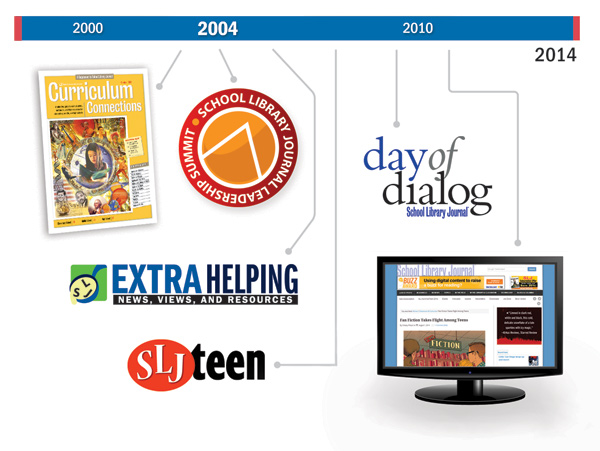
Stargazing: Art by the top children’s book illustrators has graced our annual Best Books issue since 1998.
RELATED
The job outlook in 2030: Librarians will be in demand
The job outlook in 2030: Librarians will be in demand
ALREADY A SUBSCRIBER? LOG IN
We are currently offering this content for free. Sign up now to activate your personal profile, where you can save articles for future viewing






Add Comment :-
Be the first reader to comment.
Comment Policy:
Comment should not be empty !!!